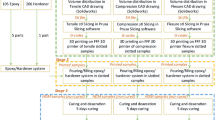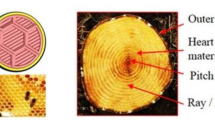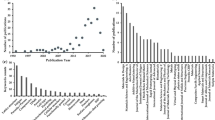Abstract
Additive manufactured (AM) cellular structures have received much research attention due to their specific strength and energy absorption capabilities, and a range of geometric, material and processing parameters has been found to affect their manufacturability and mechanical performance. To investigate the effects of wall thickness and cell size on manufacturability and mechanical properties, gyroid lattice structures were fabricated from acrylonitrile butadiene styrene (ABS) using fused deposition modelling (FDM) and tested under quasi-static loading. Gyroids were confirmed to be highly manufacturable structures, and increasing density was found to further improve manufacturability. Mechanical behaviour was found to be dominated by the geometry and topology of the gyroids rather than manufacturing effects. Mechanical testing results were consistent with the predictions of the Gibson-Ashby model for cellular structures, and formulae were generated to predict the mechanical behaviour of ABS gyroid lattice structures produced by FDM. This work provides tools to enable a priori prediction of the mechanical behaviour of ABS gyroids manufactured by FDM and a greater understanding of opportunities and limitations of these structures.


















Similar content being viewed by others
Notes
Relative density is the ratio of density of the cellular structure (ρ*) to the density of the structure’s parent material (ρs).
Specimen “3C050W” has three cells in each direction and a walk thickness of 0.5 mm.
Abbreviations
- ABS:
-
Acrylonitrile butadiene styrene
- AM:
-
Additive manufacture
- CAD:
-
Computer-aided design
- DFAM:
-
Design for additive manufacturing
- EBM:
-
Electron beam melting
- FDM:
-
Fused deposition modelling
- GD:
-
Generative design
- MEX:
-
Material extrusion
- μCT:
-
Micro-computed tomography
- PLA:
-
Polylactic acid
- SLM:
-
Selective laser melting
- SLS:
-
Selective laser sintering
- STL:
-
Stereolithography file
- TPMS:
-
Triply periodic minimal surface
- C :
-
Number of cells
- L :
-
Cell length of the cubic structure (mm)
- W :
-
Wall thickness (mm)
- P * :
-
Property of a cellular structure
- P s :
-
Property of bulk material
- E* :
-
Static modulus of a cellular structure
- E s :
-
Static modulus of bulk material
- σ * :
-
Strength of a cellular structure
- σ s :
-
Strength of bulk material
- σ y :
-
Specimen yield strengths
- ρ ∗ :
-
Density of cellular structure
- ρ s :
-
Density of solid bulk material
- X Y Z :
-
Cartesian coordinates
- ωx, ωy, ωz :
-
Cell frequencies in X, Y, Z
- R 2 :
-
R-squared value indicating percentage of variance predicted by regression model
- \( {R}_{\mathrm{adj}}^2 \) :
-
Adjusted R-squared value considering number of terms in regression model
- \( {R}_{\mathrm{pred}}^2 \) :
-
Predicted R-squared value
References
Brandt M et al (2013) High-value SLM aerospace components: from design to manufacture. Trans Tech Publ
Hao L et al (2011) Design and additive manufacturing of cellular lattice structures. In: The International Conference on Advanced Research in Virtual and Rapid Prototyping (VRAP). Taylor & Francis Group, Leiria
Harris JA, Winter RE, McShane GJ (2017) Impact response of additively manufactured metallic hybrid lattice materials. Int J Impact Eng 104:177–191
Leary M et al (2018) Inconel 625 lattice structures manufactured by selective laser melting (SLM): mechanical properties, deformation and failure modes. Mater Des 157:179–199
Alabort E, Barba D, Reed RC (2019) Design of metallic bone by additive manufacturing. Scr Mater 164:110–114
Yan C et al (2014) Advanced lightweight 316L stainless steel cellular lattice structures fabricated via selective laser melting. Mater Des 55:533–541
Hao Z et al (2019) Lightweight structure of a phase-change thermal controller based on lattice cells manufactured by SLM. Chin J Aeronaut 32(7):1727–1732
Brennan-Craddock J et al (2012) The design of impact absorbing structures for additive manufacture. J Phys Conf Ser 382:012042
Zadpoor AA (2018) Mechanical performance of additively manufactured meta-biomaterials. Acta Biomater
Fee C (2017) 3D-printed porous bed structures. Curr Opin Chem Eng 18:10–15
Germain L et al (2018) 3D-printed biodegradable gyroid scaffolds for tissue engineering applications. Mater Des 151:113–122
Maharjan GK et al (2018) Compressive behaviour of 3D printed polymeric gyroid cellular lattice structure. IOP Conf Ser Mater Sci Eng 455:012047
Jo W et al (2017) 3D printed hierarchical gyroid structure with embedded photocatalyst TiO2 nanoparticles. 3D Print Addit Manuf 4(4):222–230
Ebel, E. and T. Sinnemann, Fabrication of FDM 3D objects with ABS and PLA and determination of their mechanical properties. RTejournal, 2014. 2014(1)
Rodríguez-Panes A, Claver J, Camacho AM (2018) The Influence of manufacturing parameters on the mechanical behaviour of PLA and ABS pieces manufactured by FDM: a comparative analysis. Materials 11(8):1333
Dawoud M, Taha I, Ebeid SJ (2016) Mechanical behaviour of ABS: an experimental study using FDM and injection moulding techniques. J Manuf Process 21:39–45
Yang E et al (2019) Effect of geometry on the mechanical properties of Ti-6Al-4V gyroid structures fabricated via SLM: a numerical study. Mater Des:108165
Maskery I et al (2017) Compressive failure modes and energy absorption in additively manufactured double gyroid lattices. Addit Manuf 16:24–29
Maskery I et al (2018) Insights into the mechanical properties of several triply periodic minimal surface lattice structures made by polymer additive manufacturing. Polymer 152:62–71
Yánez A, Herrera A, Martel O, Monopoli D, Afonso H (2016) Compressive behaviour of gyroid lattice structures for human cancellous bone implant applications. Mater Sci Eng C 68:445–448
Yan C et al (2012) Evaluations of cellular lattice structures manufactured using selective laser melting. Int J Mach Tools Manuf 62:32–38
Podroužek J et al (2019) Bio-inspired 3D infill patterns for additive manufacturing and structural applications. Materials 12(3):499
Gandy PJF, Klinowski J (2002) Nodal surface approximations to the zero equipotential surfaces for cubic lattices. J Math Chem 31(1):1–16
Schoen AH (1970) Infinite periodic minimal surfaces without self-intersections
da Silva CMM (2019) 3D printing of Gyroid structures for superior structural behaviour. Mater Sci
Ahn D et al (2009) Representation of surface roughness in fused deposition modeling. J Mater Process Technol 209(15):5593–5600
Ashby MF et al (2000) Metal foams: a design guide. Elsevier
Maconachie T et al (2019) SLM lattice structures: properties, performance, applications and challenges. Mater Des:108137
Deshpande VS, Ashby MF, Fleck NA (2001) Foam topology: bending versus stretching dominated architectures. Acta Mater 49(6):1035–1040
International, A (2015) Additive manufacturing — general principles — terminology. International Organization for Standardization
Ahn SH (2002) Anisotropic material properties of fused deposition modeling ABS. Rapid Prototyp J 8(4):248–257
Chang MCO et al (1997) Acrylonitrile-butadiene-styrene (ABS) polymers. Marcel Dekker Inc., New York
Suzuki M, Wilkie CA (1995) The thermal degradation of acrylonitrile-butadiene-styrene terpolymei as studied by TGA/FTIR. Polym Degrad Stab 47(2):217–221
Harper CA (1975) Handbook of plastic and elastomers. McGraw-Hill, New York
McCullough EJ, Yadavalli VK (2013) Surface modification of fused deposition modeling ABS to enable rapid prototyping of biomedical microdevices. J Mater Process Technol 213(6):947–954
Mohamed OA, Masood SH, Bhowmik JL (2015) Optimization of fused deposition modeling process parameters: a review of current research and future prospects. Adv Manuf 3(1):42–53
Jin Y et al (2017) A non-retraction path planning approach for extrusion-based additive manufacturing. Robot Comput Integr Manuf 48:132–144
Jiang J, Xu X, Stringer J (2019) Optimization of process planning for reducing material waste in extrusion based additive manufacturing. Robot Comput Integr Manuf 59:317–325
Jiang J, Stringer J, Xu X (2018) Support optimization for flat features via path planning in additive manufacturing (3D printing and additive manufacturing)
Lensgraf S, Mettu R (2016) Beyond layers: a 3D-aware toolpath algorithm for fused filament fabrication, pp 3625–3631
Rodriguez J, Thomas J, Renaud J (2000) Characterization of the mesostructure of fused-deposition acrylonitrile-butadiene-styrene materials. Rapid Prototyp J 6:175
Ang K et al (2006) Investigation of the mechanical properties and porosity relationships in fused deposition modelling-fabricated porous structures. Rapid Prototyp J 12:100–105
Xue W et al (2019) Effect of porosity on mechanical properties of 3D printed polymers: experiments and micromechanical modeling based on X-ray computed tomography analysis. Polymers 11(7):1154
Stratasys (2017) ABS-M30: Production-Grade Thermoplastic for FDM 3D Printers
Bellehumeur C et al (2004) Modeling of bond formation between polymer filaments in the fused deposition modeling process. J Manuf Process 6(2):170–178
Bucknall CB, Smith RR (1965) Stress-whitening in high-impact polystyrenes. Polymer 6(8):437–446
Ashby M (2005) The properties of foams and lattices. Philos Trans R Soc A Math Phys Eng Sci 364(1838):15–30
Gibson LJ, Ashby MF (1999) Cellular solids: structure and properties. Cambridge University Press, Cambridge
Shilo, D., et al., Printing the future—updates in 3D printing for surgical applications. Rambam Maimonides Med J, 2018. 9(3)
Tino R et al (2019) Additive manufacture of gyroid structures: a method to fabricate low Hounsfield-equivalent AM materials. Aust Phys Eng Sci Med 42:285–401
Acknowledgements
This research was conducted by the Australian Research Council Industrial Transformation Training Centre in Additive Biomanufacturing (IC160100026).
The authors acknowledge the facilities, and the scientific and technical assistance of the RMIT Advanced Manufacturing Precinct.
Funding
This research is funded by the members of the ARC Training Centre for Lightweight Automotive Structures and from the Australian Research Council (Grant Reference IC160100032).
Author information
Authors and Affiliations
Corresponding author
Additional information
Publisher’s note
Springer Nature remains neutral with regard to jurisdictional claims in published maps and institutional affiliations.
Mechanical properties of gyroid specimens
Mechanical properties of gyroid specimens
The mechanical properties of all tested specimens are presented in Table 14.
Rights and permissions
About this article
Cite this article
Maconachie, T., Tino, R., Lozanovski, B. et al. The compressive behaviour of ABS gyroid lattice structures manufactured by fused deposition modelling. Int J Adv Manuf Technol 107, 4449–4467 (2020). https://doi.org/10.1007/s00170-020-05239-4
Received:
Accepted:
Published:
Issue Date:
DOI: https://doi.org/10.1007/s00170-020-05239-4




